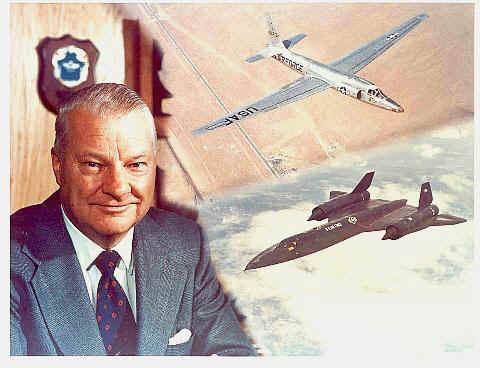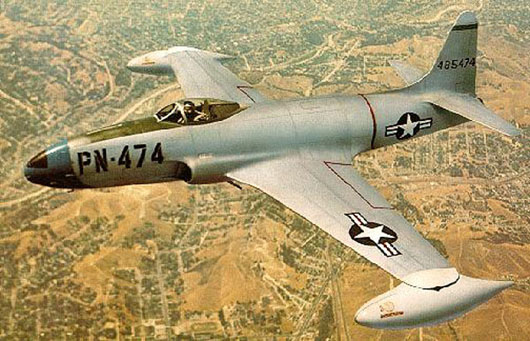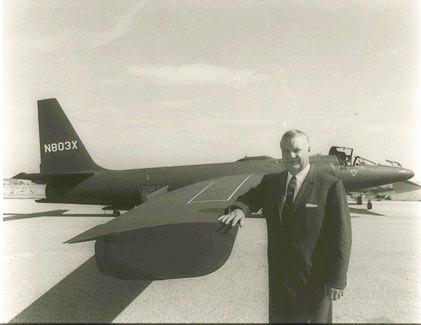Quick prototypes. Small teams. No bureaucracy. No lengthy documentation. Limited meetings. A Skunk Works approach to design. They were all essential to Clarence (“Kelly”) Johnson’s process for creating some of the most remarkable planes of the past century, including the Lockheed SR-71 Blackbird [SvN]. Johnson was once described by Time Magazine as perhaps the most successful aviation innovator since Orville and Wilbur Wright.

Six months for the first jet fighter
Head Skunk [Air & Space Magazine] describes how, in 1943, Johnson promised a commanding officer the first jet fighter in six months. The prototype was designed in 150 days in a space built out of engine crates and a circus tent.
Johnson flew back to Burbank to present the project to Lockheed president Robert Gross. The company was working for the war; with three shifts a day, six days a week, it produced 28 airplanes daily. There was no space and there were no people for another project. But Gross, who thought Johnson walked on water, okayed the project and put him in charge of it.
Johnson went around the factory collecting people: “I simply stole them,” he later wrote. He set up a secret shop beside the wind tunnel in a space walled with wood from Hudson engine crates and roofed with a circus tent. Once the facility had been set up, the time remaining for actual design and construction of America’s first jet fighter was 150 days. This was not impossible; North American had designed and built the P-51 Mustang prototype in even less time. Johnson’s team beat the deadline—and the budget—with what would become the P-80 Shooting Star.

The P-80 Shooting Star.
Skunk Works
Johnson’s Skunk Works was the official alias for Lockheed Martin’s Advanced Development Programs (ADP). Of course, the term is now used in many fields to describe a small group that works under the radar on a project.
Kelly Johnson’s Skunk Works was a revolt against the formalities of conventional industry. It was a throwback to a time when airplanes were created by small teams who all broke for lunch together. Johnson crammed a small number of capable people into close proximity, so that “engineering shall always be within a stone’s throw of the airplane.” He believed in the freewheeling inventive genius of individuals—particularly himself; he resented the intrusions of committees of government bureaucrats with their meddlesome meetings, and rebelled against their minutely detailed specifications.
He pared away procedural dross: Whatever used up time without advancing the project was banned—even visits from the customer. Finished drawings were not required; shop men were encouraged to work from sketches and when possible to develop parts directly on the airplane. Decisions, once made, would not be second-guessed; good enough was good enough. Meetings were limited to two or three essential participants. Initial flight tests would be conducted by the builders—not, as was usual at the time, by the customer’s pilots.
To the extent that an organization could, the experimental shop would behave like a single person…
While the Skunk Works is usually viewed as a unique creation of Kelly Johnson’s, it was so only in the context of a bloated American aerospace industry. France’s Marcel Dassault used small, elite staffs in the same way that Johnson did, developing the Mirage IV supersonic bomber with a design team of fewer than 100. The revolutionary vertical-takeoff Hawker P.1127, which became the Harrier, emerged from a similar-size team of designers. Compared with the British or French, American firms typically employed two or three times as many people on a project.
Lockheed still lists Kelly’s Skunk Works®’ rules of operation at its site.
3. The number of people having any connection with the project must be restricted in an almost vicious manner. Use a small number of good people (10% to 25% compared to the so-called normal systems).
4. A very simple drawing and drawing release system with great flexibility for making changes must be provided.
Other interesting Johnson facts
The Air & Space Magazine article also notes that Johnson was a flight-test engineer—the person who collects data during test flights—and joked that he needed one good scare a year to keep in touch with what he called “the concern of the pilot” (i.e. staying alive).
Johnson also hated excessive documentation and big meetings, according to his Skunk Works successor Ben Rich.
Kelly disliked long written reports, so he limited any report addressed to him to a length no longer than 20 pages. Kelly said, “I don’t have time to read long reports of anything”. He also limited meetings to 15 people or less.
The Time article mentions that Johnson’s early experience of working summer jobs in auto plants gave him hands-on exposure to metal machining:
His early experience in metal machining acquired during summer jobs in auto plants proved invaluable in working the heat-resistant titanium sheets needed for the SR-71’s tough skin, which heats up to cherry red temperatures of 630° F. during flight. Johnson deplores the trend toward specialization with the lament of a designer who also knows how to handle machine tools. “Some of the fellows in the Skunk Works never had any cutting oil splashed on them.” He expects more and more future decisions to be made by committees of experts with no experience beyond their own specialties. Trouble is, he says, committees “never do anything completely wrong, but they never do anything brilliant either.”
See more of Johnson’s planes at this collection of his airplane designs.

Johnson with an early variant of the U-2.

Eric Hayes
on 20 Sep 10Fascinating stuff.
GregT
on 21 Sep 10On December 16, 1953, Johnson personally witnessed a UFO, and would later reflect on this experience by saying, ‘For at least five years I have definitely believed in the possibility that flying saucers exist — this in spite of a good deal of kidding from my technical associates. Having seen this particular object on December 16th, I am now more firmly convinced than ever that such devices exist, and I have some highly technical converts in this belief as of that date.’
Polo Valdovinos
on 21 Sep 10Some of the best cars ever made like the original BMW M3, Pontiac GTO, came out of skunk works. A small, passionate team can do great things.
Colin
on 21 Sep 10It’s nice to see stories about “big” things that are really small things that only seem big because most people don’t understand them. Big teams don’t deliver on big ideas. Rather, the right team does.
Randall
on 21 Sep 10Kelly Johnson has been a hero of mine since I was about 10, and he was one of the primary reasons I wanted to be an aerospace engineer. Many years of hard work later, I got my Aerospace Engineering degree (and even a masters), and worked for 8 years in the aerospace industry working on advanced military aircraft projects. I was fortunate to work on a lot of small ‘skunk-works’ style projects, but even those had a lot of bureaucracy. The larger and more visible projects were unbelievable. I was so disappointed and disheartened that within 10 years I left that industry for the world of startups and software, where its actually pretty easy to operate in the same way that Kelly did.
Sean
on 21 Sep 10I’m just shocked to learn the U-2 is called the Dragon Lady. :)
Ruben Berenguel
on 21 Sep 10This was an interesting read. It looks like the more I procrastinate, the more I read about rapid prototyping and continuous improvement.. And the more I have to try to use them while writing my thesis (theoretical math). There are ways (continuous improvement being one), but I need to improve the part on rapid prototyping and ‘good enough sketches’. My advisor encourages me… but what is ‘good enough’ for me lacks essential details for him. I’ll keep on trying…
Cheers,
Ruben
Dan
on 21 Sep 10As cool as this is, let’s not forget that the teams were building prototypes. SvN authors often promote this kind of design and team building for applications and sites that will go public and support paying customers; the military aviation equivalent of that would be building planes that soldiers flew in combat.
It’s a bit misleading to take the man’s success in prototyping and use it to prop up your ideas about building real-world software. I’m sure that when it came time to build an actual plane used by actual soldiers, they wrote one hell of a design spec; that spec was probably reviewed by dozens of specialists, from theoretical physicists to material engineers to cognitive scientists. I’d go so far as to predict that significant technicial changes were made based solely on which suppliers held certain government contracts at the time; such information usually comes after reviews by bureaucrats and/or unpleasant meetings.
This is not to say that your system does not work for numerous types of software projects, but when you post stories like this, it implies that it’s The One True Way that can improve all projects and work situations. Sometimes, the breadth or the importance of a project outweighs the desire for efficiency and individual happiness.
Bob
on 21 Sep 10committees “never do anything completely wrong, but they never do anything brilliant either.”
I couldn’t agree more. I love working in multiple fields (coding, carpentry, plumbing, electric, HVAC, auto and aircraft mechanics, woodwork, metalwork, sewing, cooking, etc.) because they’re all interesting in their way. And I LOVE it when skills from one field unexpectedly payoff in another field.
If you’re over-specialized, you don’t know what you’re missing.
FN
on 21 Sep 10The biggest difference between now and then…what makes this impossible today is not that our engineers are less capable, is not that we are more bureaucratic and is not that we’re less motivated now.
The difference is that back then, we were indifferent to failure that cost lives.
And not just in development/testing. Once planes were deployed, if a plane didn’t come back from a mission it was “lost in action” independent if the wing just broke off in flight over some stretch of water. Read this excerpt from Wikipedia:
So this “no bureaucracy” craze makes no sense for modern aviation design but makes a lot of sense where lives are not at risk (as is the case with a lot of software development, but not all).
That’s my $0.02.
Anonymous Coward
on 21 Sep 10In god we trust. All others we monitor
Tom G
on 21 Sep 10One of my favorite books of all time is Skunk Works, by Ben Rich.
When I read it, I didn’t get to bed until 4AM because I literally could not put it down.
Out on the west coast I recently saw an SR-71 in a museum, and like the time I saw the pioneer spacecraft in the Smithsonian in DC it made me proud to be a human being. We can really do amazing things to be extraordinarily proud of.
Michael Fever
on 24 Sep 10I seen a documentary back in the late 90s i think it was, maybe early 2000’s where a guy was saying he worked along side aliens at skunkworks. This was around the same time of the alien autopsy video was released. I guess we can just chalk this up to another Fox News story eh….
Paul
on 24 Sep 10“good enough was good enough.” – LOVE IT!
This discussion is closed.